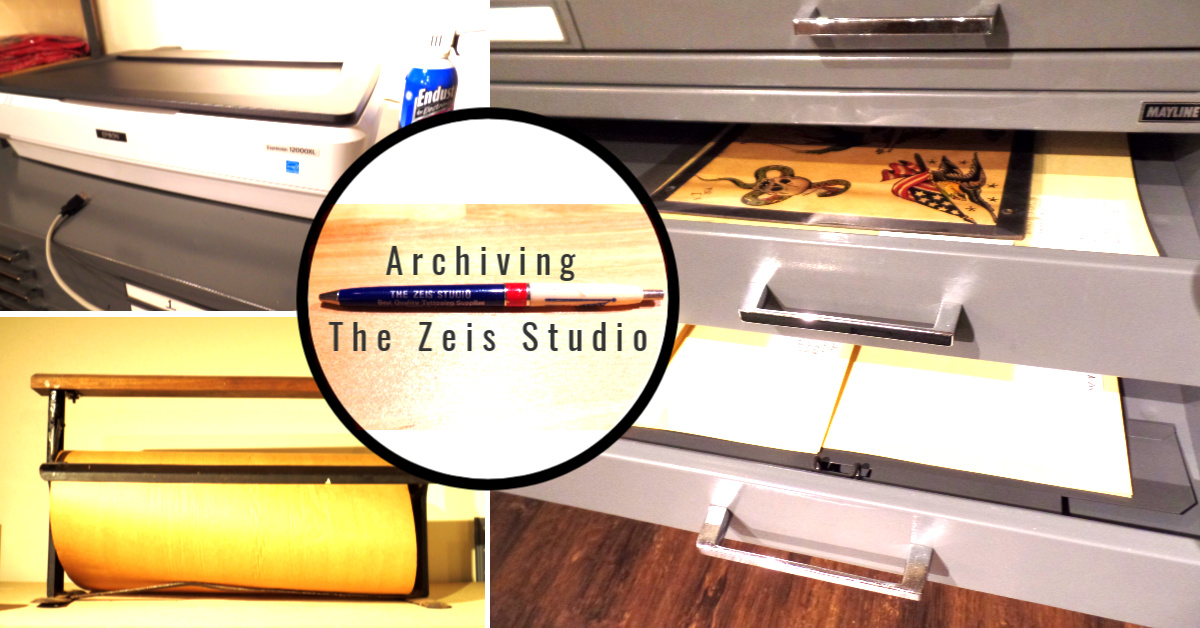*This post contains affiliate links. As an Amazon Associate I earn from qualifying purchases. This is at no expense to you and helps keep The Zeis Studio going. If you’d like more information please view my Affiliate Disclosure.
“A people without the knowledge of their past history, origin and culture is like a tree without roots.” ~Marcus Garvey
I’m proud to be helping to take care of tattoo history. I take it very seriously and hold it close to my heart. Tattooers and tattoo enthusiasts have often told me how important Milton Zeis was to them. I am doing my best to preserve and conserve the work and legacy of my great-grandfather Milton Zeis and sharing it all with you.
It’s taking me a long time to get to this point, but I’m happy and excited I’m finally here. I’ve done research over the years on ways to preserve antique art and want to share with you how I am doing so. Feel free to let me know what you think.
As we know tangible things are often finite. That’s why the internet and digital age are so intriguing in helping to preserve history. We’ve learned this lesson through the tragedy that destroyed Mike and Mary Skiver’s vintage tattoo collection, museum, and home. And also, the basement flood that destroyed lots of Milton’s work many decades ago. I’m working to preserve The Zeis Studio’s collection digitally in hopes that it can live well past its physical days.
How to Conserve Vintage Tattoo Art
Take care of each physical piece appropriately.
-Wash Hands, Wear Gloves
Before handling artwork make sure you have washed your hands. Additionally, wear cotton gloves or powder-free nitrite gloves so that you do not transfer oil or dirt onto your art and damage it. DO NOT use rubber or latex gloves as they were made with chemically unstable materials that may react with your artwork.
-Store in Folders And Or Plastic Sleeves
To keep your art safe from chemicals and damage store art in either a folder or plastic sleeve. I like to keep each piece in both a folder and a plastic sleeve. This helps with organization and recording.
“Mats, folders, and storage boxes should be made of cotton rag or 100 percent chemically purified wood pulp with an alkali reserve equivalent to two percent calcium carbonate and buffered to a pH of 7.5 to 10”. In other words, they should be acid-free. “Matboard and folders should be rigid enough to provide adequate support. Store artwork in mats or within individual enclosures that are larger than the items”.
Plastic sleeves should be constructed of uncoated polyester, polypropylene, or polyethylene and not be frosted. They protect from dust, light, and oil from hands.
Resource: https://learning.culturalheritage.org/caring-treasures
Bring into the Digital World
All proceeds from The Zeis Studio have gone to preserving the works of Milton Zeis. I have purchased an Epson Expression 12000XL Graphic Arts Scanner to help with preserving everything and shortly I will be sharing with you. Getting my collection digital through photography, scanning and videography is my goal. This scanner is a beast and can do so many things like one-touch color restoration and dust removal. For my uses, I want to capture everything at their basic, purest form – meaning no color brightening, no dirt erasing, and really just no altering of any kind. I just wanted a great, professional scan.
Catalog for Organization
Taking a lesson from museum cataloging I’ve created both an accession number and object ID for each piece in the collection to help keep things organized. It may not be exactly how museums build theirs, but it is custom to this collection. Learn more about the “Accession Process”. http://www.museumsoftware.com/download/pp4-5.pdf
Make your Mark
And for those of you building new tattoo flash or art pieces… please, please, please sign and date it! When you become famous later it will make things much easier for those that come after you. Thank you! 😉
How are you preserving/conserving tattoo history? Let me know in the comments…





